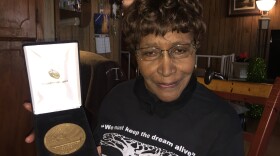Alabama Public Radio is celebrating forty years on the air in 2022. The APR news team is diving into our archives to bring you encore airings of the best of our coverage. That includes this story from 2016. The motion picture Race premiered that year. It was about Alabama native Jesse Owens who won four medals in the 1936 Olympic Games in Berlin. APR reporter MacKenzie Bates brought us the story of how Owens is remembered in his Alabama hometown. Here’s that story from the APR archives.
When you talk about the Olympics, names like swimmers Michael Phelps and Mark Spitz or gymnast Gabby Douglas may come to mind. But in 1936, Alabama Native Jesse Owens staked his claim as one of the greatest Olympians in American history.

Owens would capture four gold medals at the 1936 Olympic Games in Berlin. He took top honors in the 100 meter and 200 meter relays, the four-by-one hundred meter relay and the long jump—two setting Olympic records in the process…
Owens was born in Oakville, almost 40 miles southwest of Huntsville in 1913.
“As Ruth Owens told my husband on one visit, ‘Every four years, Jesse comes alive.’”
That’s Nancy Pinion. She’s a co-director of the Jesse Owens Museum, which opened in 1996.
“Well, when the museum was built, we didn’t really understand what that meant,” Pinion says. “Now 18 years later, it’s played out every four years, coinciding with the Summer Olympics.”
The museum immortalizes Owens and his Olympic accomplishments. Each year, up to seventy thousand people come from across the country and around the world to recognize his achievement. There is a place for kids to run the long jump. Behind the museum, there is a statue of Owens bursting through the Olympic rings. It’s symbolic of how the runner broke barriers during that time.

The movie “Race” tells the story of Owens and his rise to fame. He won all of his gold medals in the 1936 games on the eve of World War two. Adolf Hitler was hard at work persecuting Jews and other minorities and promoting his vision of a master race.
“Which is where the title comes from, Race,” Pinion says. “It was a real struggle for him and you’ll see him go through that struggle whether to go. Whether that was right to do at the time and I think he made the right decision.”
Owens’ victories in Berlin was not well-received by the Nazis. He was the first African-American track and field athlete to win four medals in the Olympics until Carl Lewis did it in Los Angeles in 1984. During the games, Hitler would meet with other gold medal winners. Owens did not get the same courtesy. However, he did get a ticker-tape parade in New York City after he came back to the states.
Pinion saw the movie with members of the Owens family at a screening in Chicago last week. She enjoyed it more than others because of her ties to the museum.
“And it’ll be even better for those who are lucky enough to have visited the Jesse Owens Park and Museum and seen his birth home replica,” Pinion says. “Either before or after the movie, preferably before the movie because you have a better perspective of what comes before or after the movie.”

Our visit was on a cold, rainy day at the Jesse Owens Museum. The weather kept the crowds away—but not everyone.
“He’s just an American icon and I think he made America Better.”
That’s Melody Weiler. She’s a junior at Parkview High School in Lilburn, Georgia. She and her family drove from Atlanta. Weiler was assigned to write a paper profiling a prominent African-American during Black History Month. She picked Jesse Owens, and come rain or shine, she wanted to visit his hometown…
“What made him love to run and to get something new out of what I want to get out of the season and maybe try and use some of his tactics,”Weiler says.
Weiler is also a member of her school’s track team.
“I just think he was a really exemplary runner and I think he’s really a great model of what American athletics should be,” Weiler says. “He’s pretty much the definition of the sport.”
The 1996 Olympic Games were held in Atlanta. As the Olympic torch made its way to its final destination, it had to make its way through Alabama. Museum director James Pinion saw the route the torch was going to make and it didn’t come close to Owens’s hometown.
“And I’ve said I noticed on the map of the torch route that you’re coming from Nashville straight down to Huntsville and from there, straight down to Birmingham,” James says. “I said now if you make a 40 mile loop from Huntsville, you’ll come right through Jesse Owens’s birthplace.”
A few weeks later, James got a letter from the Olympic Torch committee saying it would make the small detour to honor Jesse Owens.
The Torch made its way to Oakville on June 29th, 1996. The day Owens Memorial Park was dedicated. More than 10-thousand people converged on the park for the ceremony. Owens’s grandson, Stuart Owen Rankin carried the Olympic torch through the park that day.
And as a new generation of runners, swimmers, and gymnasts go for the gold during the Summer Olympics in Rio De Janeiro, the legacy of Owens will continue to shine both on the field and the silver screen.





















